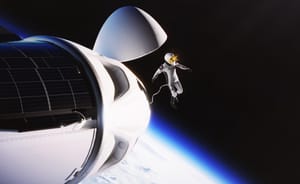
Aug 26, 2024
What is Polaris Dawn?
Polaris, better known as "The North Star," holds significant importance in many cultures around the world. In Norse mythology, Polaris was considered a jewel that held the sky together. In various societies, the star was believed to protect travelers and help those who passed away find their place in the afterlife. By the 5th century, it was noted that Polaris’s position never changed, making it an undying light that guided humanity wherever it needed to go.
That same passion is being rekindled in the modern day. A spacecraft, embodying the resilience necessary to push the boundaries of what private spaceflight has achieved, a stepping stone to what humanity can achieve. Let me introduce you to the Polaris Dawn mission, and its predecessor Inspiration4.
Inspiration4
Inspiration-4 was the world’s first all-civilian mission to orbit, led by Jared Isaacman, CEO of Shift4 Payments and an experienced pilot. The mission launched from Kennedy Space Center's historic Launch Complex 39A, the mission took a three-day journey around low-Earth orbit, covering over 90% of Earth's population. The mission, which raised over $240 million for St. Jude Children's Research Hospital, marked a significant milestone in the era of human spaceflight and exploration.
The mission included ultrasounds, microbe samples, and various health experiments on untrained civilians, in collaboration with SpaceX, TRISH at Baylor College of Medicine, and Weill Cornell Medicine. These experiments aimed to study the effects of spaceflight on human health. During the journey, an alarm went off due to a toilet malfunction. On September 18, 2021, the spacecraft Resilience safely splashed down in the Atlantic Ocean north of Cape Canaveral and was recovered by the ship GO Searcher. The crew members exited the spacecraft in the following order: Arceneaux, Proctor, Sembroski, and Isaacman.
This mission in many ways was what sparked the start of Polaris although not the formal start. The Polaris program was announced by Jared Isaacman in February 2022, five months after the first all-private astronaut mission,
Background
Funded by Isaacman and operated in close collaboration with SpaceX teams, the program's first launch, titled "Polaris Dawn," features Isaacman as the commander alongside three crewmates: Pilot Scott Poteet, Mission Specialist Sarah Gillis (who also oversees SpaceX's astronaut training program), and Medical Officer Anna Menon (who manages SpaceX crew operations and serves in mission control). The Polaris Dawn crew aims to build on the achievements of Inspiration4, with Isaacman stating,
"On Polaris Dawn, we endeavor to achieve the highest Earth orbit ever flown."

At its peak altitudes, the Polaris Dawn mission will pass through portions of the Van Allen radiation belt — the donut-shaped swaths of magnetically-trapped, highly-energetic charged particles that surround Earth — providing the crew the opportunity to collect data on the effects of space radiation exposure on human health as among the mission's science research objectives.
The Ride
Every great mission needs its iconic vehicle. Yuri Gagarin roared off the pad in the Iconic R7 Vostok, Apollo 11 roared on top of a Saturn V, and Polaris Dawn soars on top of Falcon9!

Falcon 9 is a reusable, two-stage rocket designed and manufactured by SpaceX for the reliable and safe transport of people and payloads into Earth orbit and beyond. Falcon 9 is the world’s first orbital class reusable rocket. Reusability allows SpaceX to refly the most expensive parts of the rocket, which in turn drives down the cost of space access.
- SpaceX's website
Falcon 9 has achieved 255 consecutive landings as of August 25th. The Falcon 9 in conjunction with Crew Dragon has been delivering crew to and from the ISS since 2020. The current iteration, Falcon 9 Block 5, has been flying since 2018.
Crew Dragon

The Crew Dragon spacecraft has a diameter of 4m and a height of 8.1. It has a pressurized volume of 9.3 m^3 and a trunk volume of 37 m^3. Crew Dragon incorporates an integrated pusher launch escape system consisting of eight SuperDraco engines, capable of accelerating the capsule away from the launch vehicle in an emergency. The spacecraft also utilizes custom-fitted IVA suits in the case of a cabin depressurization event. Dragon is also designed for reusability excluding the trunk. the capsule was initially to be used for just 5 missions but is now certified for up to 15.

The Dragon spacecraft is capable of carrying up to 7 passengers to and from Earth orbit, and beyond. It is the only spacecraft currently flying that is capable of returning significant amounts of cargo to Earth, and is the first private spacecraft to take humans to the [international] space station.
- Spacex.com
Crew Dragon marked the return of human spaceflight to the United States and remains a vital part of US space operations.
Resilience
Just like the resilience that Polaris has brought humanity, Polrais Dawn will launch on a just as resilient spacecraft. If you couldn't tell already, the capsule that launched inspiration4 and will launch Polaris Dawn is called Resilience.
Resilience fulfilled SpaceX's first-ever crew rotation to the ISS, and has been specially modified with an airlock for the EVA on Polaris Dawn.

This special modification will replace the docking port section present on most dragon capsules with a hatch for EVA operations.
Mission Profile & Changes
No earlier than (NET) September 8th SpaceX’s Falcon 9 rocket will launch the Polaris Dawn mission from Florida. Dragon and the Polaris Dawn crew will spend up to five days in orbit, during which they will work towards several key objectives to further SpaceX's goal of making life multi-planetary.
The Polaris Dawn mission represents a significant advancement in space exploration by leveraging the full capabilities of SpaceX's Falcon 9 and Dragon spacecraft. This mission aims to reach the highest Earth orbit ever achieved by a Dragon vehicle, traversing the Van Allen radiation belts. A key focus of Polaris Dawn is to enhance our understanding of spaceflight and radiation impacts on human health.
One of the mission's highlights is the first-ever commercial extravehicular activity (EVA), which will occur at approximately 700 kilometers above Earth. The crew will wear SpaceX-designed spacesuits specifically upgraded for EVA. This endeavor is crucial as it lays the groundwork for the development of spacesuits needed for future lunar bases and Martian colonies.

In addition, the Polaris Dawn crew will pioneer the use of Starlink's laser-based communication technology in space. This innovative system aims to provide essential data that will support the development of advanced communication infrastructure for future missions to the Moon, Mars, and beyond.
The mission will also focus on groundbreaking health research. The crew will utilize ultrasound to monitor and quantify venous gas emboli (VGE), aiding studies on decompression sickness. They will gather data on the radiation environment to better understand its effects on human biology and contribute biological samples for a long-term Biobank. Research will also address Spaceflight Associated Neuro-Ocular Syndrome (SANS), a significant concern for long-duration missions.
Polaris Dawn is a collaborative effort involving SpaceX and several research institutions, including the Translational Research Institute for Space Health (TRISH), BioServe Space Technologies at the University of Colorado Boulder, Space Technologies Lab at Embry-Riddle Aeronautical University, Weill Cornell Medicine, Johns Hopkins University Applied Physics Laboratory, Pacific Northwest National Laboratory, and the U.S. Air Force Academy.
This flight will lead to new scientific research that is not commonly performed. It will take full advantage of its peculiar orbit to better understand how humans can live in space.
To reduce the risk of micrometeorite impacts, SpaceX has a flexible launch schedule for the Polaris Dawn mission, enabling them to choose a time with minimal orbital debris. The Dragon capsule will first enter a highly elliptical orbit, reaching up to 1,200 kilometers (750 miles) from Earth and passing through the South Atlantic Anomaly at a low altitude of 190 kilometers (120 miles). This trajectory will expose the crew to radiation levels equivalent to three months on the International Space Station within just a few orbits.
Within an hour after launch, the crew will begin a pre-breathing protocol to reduce nitrogen in their bodies and minimize the risk of decompression sickness during the planned spacewalk on day three. During this first hour in space, the crew will conduct thorough checks of the Dragon capsule for any launch-related damage. If no issues are found, the Draco thrusters will fire, propelling the crew up to 1,400 kilometers (870 mi) away from Earth, the highest orbit of the planet ever flown by a crewed spacecraft, breaking the record set by Gemini 11,
Flight day three is dedicated to the first-ever extravehicular activity (EVA) on a commercial spaceflight mission. After extensive preparations, all four crew members will don their EVA suits, The Crew Dragon will then be fully depressurized, and Jared Isaacman along with Sarah Gillis will have the opportunity to go out for 15 to 20 minutes each to conduct various tests of the EVA suit.
Compared to the IVA suits discussed earlier, thermal management has been improved and the helmet received thermal insulation and an anti-fog treatment. During the spacewalk, a heads-up display will provide information on suit metrics. An umbilical will provide life support for these suits, similar to early Gemini suits, as opposed to the self-contained EMUs used on the ISS
Concluding Thoughts
All one can wish for is safe travels for this spaceflight mission. Polaris Dawn aims to jump off of decades of achievements. It will grasp at whats possible, and whats just out of reach! Just like how The North Star guided travelers who pushed the boundary home, Polaris will guide humanity into the future of spaceflight.



